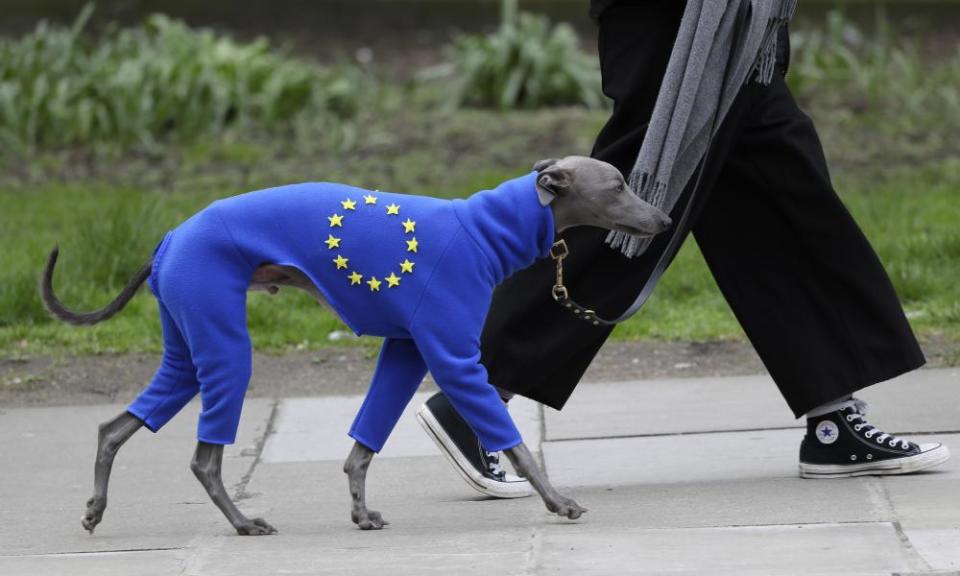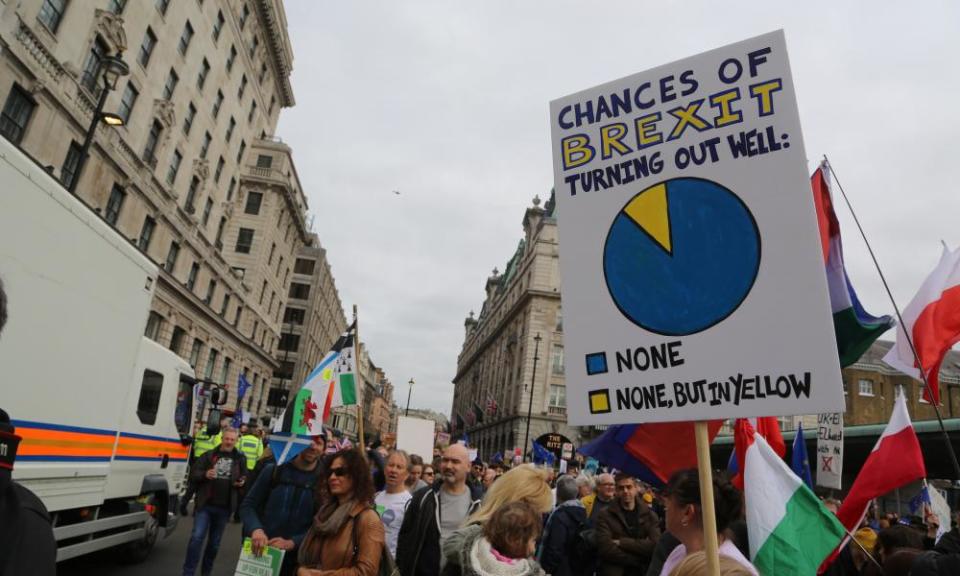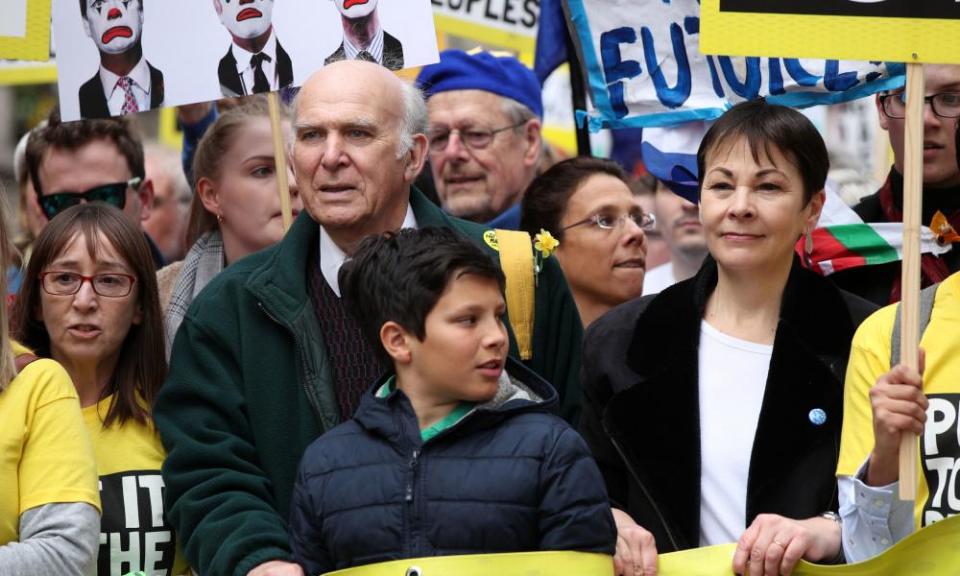Put it to the People march: a formidable sea of humanity and powerful strength of feeling

There are still a few things in public life that you cannot fake. You can fake photographs and you can fake news. You can fake conviction and you can fake emotions. You can fake a Twitter-petition and you can fake Facebook outrage. But you cannot fake an almighty crowd.
The numbers attending Saturday’s march for a second “people’s vote” on Brexit will no doubt be contested. The organisers claimed more than a million people were out; detractors inevitably argued a few thousand fewer. But make no mistake, for anyone who travelled to it, and shuffled along among it and who tried to find their way home after it, the Put it to the People march represented a formidable sea of humanity, and a powerful strength of feeling.
And let no one tell you that this was just a London crowd. By 10.30 at Speaker’s Corner there were people arriving for the high noon rendezvous from all corners of the country and beyond. Groups draped in the saltires of Scotland and the dragons of Wales. Anna Soubry MP was among the earliest arrivals, walking cheerfully down Park Lane through the gathering crowds with her daughter (“my security for the day”) having been forced to stay away from her home last night after death threats.
Meanwhile phones were alive with feeds and photos of people making their way from Newport and Newcastle, Carlisle and Canterbury. An entire train had been booked from Bristol, rattling along Brunel’s Great Western Railway into Paddington. There were overnight coaches from Inverness, dawn starts from Cornwall.
Some had gone more than the extra mile. Ed Sides, 63, had walked here from his home in Swansea over the past couple of weeks. I’d spoken to him on the penultimate leg of his journey, along the Grand Union Canal. “If I didn’t do something I felt I would regret it for the rest of my life,” he said, voicing the sentiment of many. Sides had tried to make the theme of his quest “walking and talking”: “When you talk to ardent Leavers and you meet them on the street, or by a riverbank where they are fishing or whatever, you find you can have a proper conversation,” he said. “And that’s something we all need to do in the coming days.”
Like many of the marchers, he felt that if nothing else walking had been a good way of avoiding the stress and frustrations of watching the news. “I thought, if I am sitting at home on Twitter for the next three weeks I am going to go insane.”

Humans were not the only species protesting.Photograph: Kirsty Wigglesworth/AP
That feeling was shared by those expats who had flown in from the continent who, having been denied a vote in the first referendum, were now facing the climax of three years of painful uncertainty. Rebecca MacKian, 52, who has lived in Turin for the past 15 years, joined up with 20 others from the “British in Italy” group to be here.
“If no-deal happens then the next morning we will become what the Italian government now calls an ‘illegal resident’,” she said, a status that will affect everything about her life from driving a car to continuing to run her training business. “We have literally been working every day – 1,000 days – with each other to try to get some clarity on all of it. I never thought I would become addicted to Parliament TV, but I have.”
Jason Harris, 47, had got up at 2am to be here with his 14-year-old son Oran. They lived on the frontline of backstop territory in South Armagh, Northern Ireland, three miles from the border. Harris, a landscape designer who works on both sides of the border every week, also felt he had to be here rather than shouting at the television. “It is clear that either no deal or her deal will leave things in Northern Ireland up in the air for years,” he said. “I fear we will spend the next decades just trying to get back the freedoms we have given away.”
Like many on the march his priority had changed in the past week or so, with the options narrowing and the cliff-edge looming, and the online petition to revoke article 50 climbing towards 5 million signatures. “Revoke would now be number one, number two people’s vote,” he said. That idea had travelled in this crowd. Variations of the three Rs populated signs and banners: revoke, remain and reform.
There have been many attempts to divide the respective Leave and Remain tribes since the referendum – into somewheres and nowheres, populists and globalists, gammons and snowflakes.

Marchers came from all corners of Britain.
Photograph: Anadolu Agency/Getty Images
One of the simplest distinctions, however, has always seemed to come down to that division between those who relish the idea of being cheek-by-jowl with people unlike themselves, and those who feel threatened by that idea. As the tide of protesters inched its way along Piccadilly toward Trafalgar Square it looked like an above-ground exhibition of what most Londoners experience below ground every day: the tolerant sharing of space with others. The people who had come to demonstrate voiced, above all, a conviction, to borrow that telling phrase from Jo Cox, “that we have more in common than that which divides us”. (Cox, it goes without saying, would have loved this event. Her killer would have loathed it.)
There had been suggestions that the march would be met by counter-demonstrations, but there were none in evidence. As the crowd first massed, with its blue and gold EU flags, I heard one or two shouts of “traitors” from those driving by. These “patriots” would have done well to talk to Brigadier Stephen Goodall, who led the “Veterans For EU” group.
Goodall will be 97 in June. He had travelled up from his home in Devon with four generations of his family including his great-granddaughter. During the war he helped to pull survivors out of the rubble of the Coventry bombing. He served in India and Burma and was awarded the Military Cross in 1945 for bravery behind enemy lines.
I had spoken to the brigadier the day before the march about his reasons for coming. “It was an easy decision,” he said. “There is not much time left for me to do anything and I just feel if we can even at this late stage get people thinking sensibly, then it will be worthwhile.” His great anxiety, as a former controller of the Slimbridge Wildlife Trust, was that our fractured politics would deflect us from the co-operative spirit required to combat climate change. “One thing that I always bear in mind from when we were in Malaya in the 1950s,” he said, “was this imperative that governance was first about reaching hearts and minds. We need politicians who think first of people,” he said, “not about their investments in the City of London.”
Goodall was pushed in his wheelchair near the head of the march, along with a brass band. It was impossible watching that sight not to make some comparisons with those few stubborn souls on the ill-fated “March to Leave”, moved to trudge along lonely hard-shoulders by Nigel Farage, only to find that he had turned up for the photo opportunity and left them to fend for themselves. Farage, alive to BBC requirements for “balance”, had returned to preach on Saturday to his handful of leaderless footsoldiers at a pub car park in Linby, Nottinghamshire: “You are the 17.4 million,” he told a crowd of 150.

Lib Dem leader Sir Vince Cable and Green Party MP Caroline Lucas were among those leading the march.Photograph: Yui Mok/PA
As the thousands upon thousands flowed down towards Parliament Square there was, contrarily, a spirit that the Brexiters have failed over the past three years ever to begin to convey: that of creative optimism. You saw it in the 100 and more tango dancers led by Matthew Cooper, who had met in growing numbers on each of the past three protest marches, aged between 20 and 80. And in the improvised speeches on freedom given by an Emmeline Pankhurst lookalike under the statue of the suffragette. And even in the bloke flogging Donald Trump toilet rolls from a shopping trolley to stockpile should the rationing begin.
There was a very droll Britishness in the spirit that tempered any edges of anger from the many younger voices on the march. There were lots more students’ union buses than on previous marches, and among them plenty who had lost their faith in the Labour leadership to solve the crisis and deliver on its conference commitment to campaign for a second referendum.
Power wants your body softening in your chair and your emotions dissipating on a screen. Get outside.
Timothy Snyder, historian
That brief marchers’ favourite “Oooh Jeremy Corbyn” had been replaced for several sections of this crowd by a more plaintive “Where’s Jeremy Corbyn?” The answer, perversely, was that the Labour leader was canvassing in Morecambe Bay – about as far from this event as it was symbolically possible to go.
Only one of Labour’s frontbench felt able to lend his voice to this event. Tom Watson, breaking ranks, was given something of a hero’s welcome on the speakers’ stage alongside some of those others who have emerged from the sorry parliamentary process with heads held high: Soubry, Jess Phillips, Dominic Grieve, David Lammy, Caroline Lucas; and some of those from beyond the Commons who have best articulated the cause of returning to the people to find a way through the current impasse: Michael Heseltine and Nicola Sturgeon.
Their collective message served as a reminder that when the prime minister stands up again this week and claims to speak for “the people” with her unloved deal and her fingernails-down-the-blackboard phrases about delivering Brexit, she will not speak for the million individuals who filled the wide streets and squares of the capital yesterday, or for the millions more across the country who were with them in spirit.
Watching the crowd I was reminded of a book I reviewed for this paper not long after those electoral convulsions of 2016 here and across the Atlantic. The book, On Tyranny, by the Yale historian Timothy Snyder, was a little survival guide against the digital forces of populism and the brutalist politics they promoted. Snyder called above all for a “corporeal politics” in response, for voting with paper ballots that can be counted and recounted; for face-to-face conversation, and for marching rather than online petitioning: “Power wants your body softening in your chair and your emotions dissipating on a screen. Get outside. Put your body in unfamiliar places with unfamiliar people.”
Those who did this on Saturday will no doubt be told in the coming days, as Britain determines the kind of country it will become, that they were wasting their time and effort. But this march mattered in the simple and fundamental way that mass marches always matter: as a reminder to those who make decisions in their name that democracy is not a settled state, but a shifting expression of collective will. As one little girl’s sign had it: “The people are STILL speaking”.

 Yahoo News
Yahoo News 